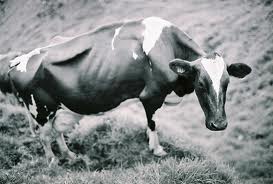We're creating monsters--the perils of agribusiness
 |
| Tomato field killed from 2,4-D drift |
 |
| Cow dying |
Mad cow disease is a horror because there is no known cure for it. In fact, the cause is not exactly known either. as the Center for Disease Control explains. What we do know is that the disease is caused and is spread by feeding cattle on food that is made from dead animals and animal waste. The best cure seems to be prevention, which means not feeding animals on food manufactured from carrion and shit, to put it in blog-blunt language.
The problems created by genetically modified crops (GMOs) are not quite so horrifying, except to farmers affected by their consequences. The problem is in a genetic chain-reaction. Crops, such as corn and cotton and soybeans, have been genetically engineered to resist a herbicide called glyphosate. It is patented under the brand Round Up by the Monsanto company. It is a weed control. When applied to a field, Round Up will kill all the vegetation in that field. Then the field is planted with crop seeds that have been engineered to resist the effects of Round Up. They grow but the weeds don't, which is a nice and neat production scheme.
There are two problems, however. The first is that we don't know what effects genetically modified crops have on humans and animals when they enter the food chain. Some evidence has been produced that GM crops cause nutritional safety and allergy problems. In some countries, genetically modified food sources are banned. Environmental problems are also emerging as an effect of this kind of crop management.
The second problem is that nature also has ways to modify plants so that they resist death by Round Up. An example is in a plant we call pigweed. It has evolved a strain that is not not only resistant to Round Up, but is so robust that it takes over cotton fields which planted with genetically modified cotton. Cotton farmers have had to hire labor to go into their fields to weed out the pigweed by hand, a return to mechanical agriculture.
Now seed companies are producing crops that have been engineered to be resistant to an old standby weed killer, 2, 4-D, which is the stuff you can buy in garden departments to kill the dandelions in your lawn. Some farmers planted crops modified to withstand 2, 4-D, sprayed the hell out of the fields, and produced some nice, weed free crops. However, 2, 4-D has a tendency to get into the air as a gas, especially in hot and humid weather, and drift around the neighborhood. Some farmers who had planted fields of tomatoes found their fields withering away under drift from their neighbors, and their crop was killed.
This is an old story. I recall one example from many years ago down near Muscatine, Iowa. That area has a very rich soil called Muscatine Silt Loam, which grows luxuriant crops of cantalope and tomatoes, as well as corn, beans, and forage. A friend from Wisconsin said the soil was so rich it was vulgar. Some farmers grow tomatoes down there for use in making ketchup. One day their neighbors sprayed the roadsides and the borders of their fields with 2, 4-D to kill the weeds and the next day the tomato growers found their crops wilting, turning yellow, and dying from the herbicide drift. They sued their neighbors and won, which did not exactly enhance neighborly relations.
 |
| A Kansas farmer surveys big-ass weeds. |
The integration and consolidation of farming to create an industrial agriculture has made farms so big that that the return to older methods of farming is not possible, much less likely. Still, the environmental hazards created by large-scale livestock confinement units and the growing concern about the nutritional quality of food produced by industrialized food production methods is also a rapidly growing factor facing farmers. Another farm crisis is looming, one that might make the crisis of the 1980s look like a bump in the road. It might create a situation much like the collapse of the housing market that was a large factor in the recession we are trying to fight our way out of. Large, debt-ridden farms are vulnerable to crop failures and market rejection of their products. Foreclosures could result in the down-sized resale of croplands to those who will utilize more labor intensive, traditional methods of agriculture.
What agriculture might become in 10 years is conjecture. What has made farming profitable currently is the use of crops to make renewable fuels. At the same time, scientists and engineers are working on the development of alternative sources of energy that could totally change the market for crops. This, added to the growing concern about food quality and nutrition, is a clearly visible possibility as a determiner of the future of farming.
Colleges of agriculture, too, have been co-opted by industrial agribusiness. The close tie, for example, of SDSU with Monsanto through its president serving on the Monsanto board of directors is indicative of how colleges of agriculture have switched the focus of their research and support from individual farmers to corporations. A further indication exemplified by South Dakota is the drastic downsizing of the cooperative extension service.
In its industrialization, agriculture has drifted further into the economics that triggered the crisis of the 1980s through its wide adoption of industrial methods of production and management. For the consumer, this means questions about the quality of food, amid rising prices.
For the farmers, it means questions about whether what once was the most successful agriculture that was the model for the world will survive.

1 comment:
There are other and better ways of agribusiness agribusiness consultant
Post a Comment